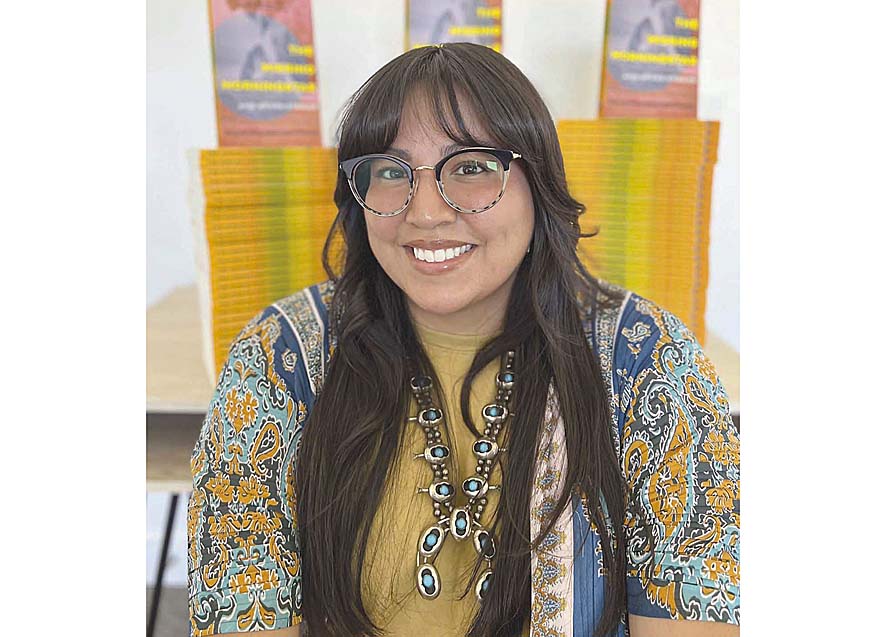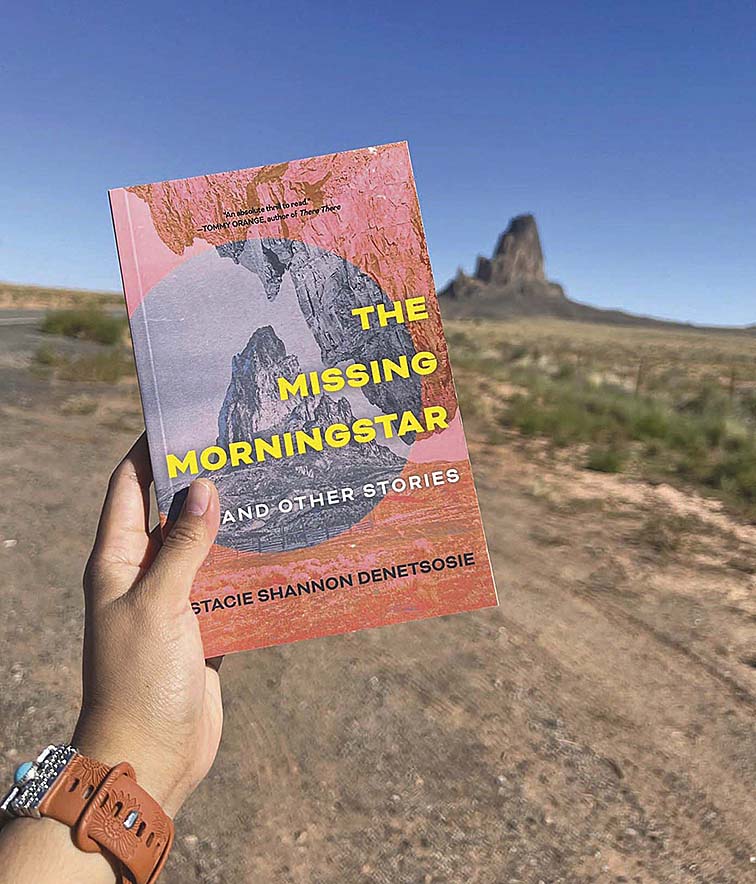
Diné writer defies settler colonialism by writing in curiosity

Courtesy | Stacie Shannon Denetsosie
Diné author Stacie Shannon Denetsosie, 30, released her debut collection, “The Missing Morningstar and Other Stories” by Torrey House Press in September. The collection comprises nine stories that speak of loss, imaginative narratives, and confronting settler-colonialism.
TWIN LAKES, N.M. – Native literature continues to grow. Diné writer Stacie Shannon Denetsosie’s debut collection, “The Missing Morningstar and Other Stories” published by Torrey House Press, adds to the list of books to look out for. Her fiction work brings honesty and eager, imaginative stories of the Diné.
“Writing these stories about home and just things that made me wonder things that caught my curiosity, like I think there are a lot of really cool stories that are done on the rez that people don’t think about,” said Denetsosie, 30, who is Tódích’íi’nii and born for Naakaii Dine’é. Her maternal grandfather is Tł’ízíłání, and her paternal grandfather is Bilagáana. She is originally from Kayenta.
Denetsosie’s stories are rooted in the land their characters occupy. She focuses on a few elements involving the land and how it illuminates personal truths of self, relationship with family, which can be complicated, and conversations about settler-colonialism.
“I feel like there’s a lot of complications in our community,” said Denetsosie, whose 144-page collection of stories was released in September. “You can think that somebody’s motivation is very simple when really their journey and their lives and the decisions they made up to that point, are a lot more complicated.
“The main reason that some of us get in complicated situations is a result of the overall structure that settler colonialism puts Native people in and that is like a struggle to survive,” Denetsosie said. “When making all your decisions out of survival, some of those decisions aren’t neat.”
Grazing the dá’ák’eh
Denetsosie grew up in Kayenta with her grandma and did everything together: grazing the cornfield, watering it, and attending ceremonies.
At 4, Denetsosie’s mother sought job opportunities elsewhere in northern Utah,
where she and Denetsosie later moved.
“I cried all the time and was sad,” Denetsosie said.
Although moving away from home was hard, Denetsosie returned every chance she had. She even painted her room a desert brown to make her feel like she was in
Kayenta.
With the transition, Denetsosie admits it was hard speaking English since she and her grandma spoke only Diné bizaad.
Fast forward to teen Denetsosie in Smithfield, Utah, where she attended Skyview High
School – she became an avid artist and writer by involving herself in those creative fields.
Denetsosie found herself reminiscing about home and her grandma, where most of stories were inspired from.
After graduating high school, Denetsosie attended Utah State University in Logan, where she earned a bachelor’s in English with creative writing emphasis and a master’s in English and literature studies.
While in her graduate program at USU, Denetsosie began working on her short stories. She often found the exercise challenging, as receiving feedback from non-Native peers defeated the purpose or intention of stories that Denetsosie shared.
Workshops at USU, remaining collection
Denetsosie began to wonder after taking part in workshops at USU, whether her stories were “Native” enough.
“I would have workshops where people are like, ‘How come your character’s name is Keisha, she’s Native American, shouldn’t it be more Native American?’ And I’d be like, ‘Hey, my name is Stacie.’ We are modern people,” Denetsosie said with a laugh.

Courtesy | Stacie Shannon Denetsosie
Diné Stacie Shannon Denetsosie, 30, is from Kayenta. She released her debut collection of short stories, “The Missing Morningstar and Other Stories” published by Torrey House Press in September.
After s graduating from USU, Denetsosie enrolled in the Institute of American Indian Arts (IAIA) in Santa Fe, where she received a master’s in fiction. That is also where she continued and finished her remaining collection.
At IAIA, Denetsosie flourished creatively as the program and mentors unlocked her wild imagination.
“I wrote a story about a mom who passes away and returns to her daughter in the form of an Amazon Alexa,” Denetsosie said. “And she (mother) asks her daughter to do a snow bath with her because the daughter still hasn’t gotten over the grief of her (mother) passing.”
“It was a lot of curiosities,” Denetsosie said, referring to one of her stories in her book about reproduction, specifically Native women’s reproduction, and how it can be complicated and political.
“I wanted to write something on that experience,” said Denetsosie, who had read little on the topic but chose to explore purely out of curiosity. “Mostly I wrote to explain the unexplainable and to create kind of the conclusion of something that I wasn’t really sure about.”
‘Lean into the truth’
Dealing with grief is hard, at any age.
Denetsosie attended a lot of funerals at a young age, which may be why she considers most of her stories to be grief narratives.
Avid readers may question how she can handle so much sadness when writing about grief. Denetsosie’s solution is to employ humor as a coping mechanism.
“I guess it is another way using humor, but I was particularly impacted by the loss of my two uncles,” Denetsosie said. “One of them I lost in a drunk driving accident, a drunk driver crashed into him.”
Denetsosie found it difficult to attend the funerals of her uncles and others at a young age and not understand fully what it meant.
“When approaching those topics, I was really worried that in my community,” said Denetsosie. “I would receive backlash because we are supposed to avoid all topics of death.”
However, she believes there is still story in those experiences and approaching it in a respectful way is vital.
“I wish I could see someone talk about grief in a way that was complex that honored the grief, but then also was able to reconcile it in some way and they were able to move past it,” she said.
Leaning into the truth can be difficult, but there is always a way out.
“I feel like our stories are getting out there, there’s so much of our experience that can feel like taboo, like you don’t look at it, you’re just supposed to muscle through it,” Denetsosie said. “That’s not what you’re supposed to do. There is immense strength in the good things in our community. I think about my mom and think, ‘What a strong and resilient woman she is’ and how she preserves despite not having the best circumstances. I find immense strength in matriarchy power.”
Reminders as a writer
Publishing a book will always be scary to an extent but will be worth it.
“I was really nervous and anxious about it (book being published),” said Denetsosie. “Mostly because I was worried that people wouldn’t like it. I was worried that the people that I wanted to read my book wouldn’t be able to find it.
“I’ve created a body of work that can appeal to different people and as a writer there is, I don’t know, a success in that feeling,” she said.
She said that some of her stories do not have “tidy endings” only because things are unsolvable.
Since publishing day, Denetsosie has visited schools and met new people, which she enjoys as she comes across individuals that share similar memories pertaining to vivid images from her book.
“It’s exciting and it also reminds me as a writer, I’m not alone. That these experiences that I have like my successes, my griefs, all those things, and that other members in my community have experienced them in a similar way,” said Denetsosie, who added that she received support and inspiration from Native female writers such as Louise Erdrich, Kelli Jo Ford and Kristiana Kahakauwila.
Writing the truth comes with consequences. However, Denetsosie encourages emerging writers to write your truth, tell your story, talk to your family, interview them; they all hold power.








 Highway 264,
Highway 264, I-40, WB @ Winslow
I-40, WB @ Winslow